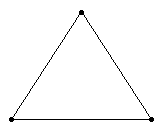Engineering Mechanics problems
- 1. In the shown figure, the tension (T) in the string will be

Options- A.

- B.

- C.

- D.
 Discuss
Discuss
Correct Answer:

- 2. The rate of change of displacement of a body is called
Options- A. velocity
- B. acceleration
- C. momentum
- D. none of these Discuss
Correct Answer: velocity
- 3. If the body falls freely under gravity, then the gravitational acceleration is taken as
Options- A. +8.9 m/s2
- B. -8.9 m/s2
- C. +9.8 m/s2
- D. -9.8 m/s2 Discuss
Correct Answer: +9.8 m/s2
- 4. A smooth cylinder lying on a __________ is in neutral equilibrium.
Options- A. curved surface
- B. convex surface
- C. horizontal surface Discuss
Correct Answer: horizontal surface
- 5. The radius of gyration is the distance where the whole mass (or area) of a body is assumed to be concentrated.
Options- A. Correct
- B. Incorrect Discuss
Correct Answer: Correct
- 6. A framed structure, as shown in the below figure, is a

Options- A. perfect frame
- B. deficient frame
- C. redundant frame
- D. none of the above Discuss
Correct Answer: perfect frame
- 7. The velocity of a particle (v) moving with simple harmonic motion, at any instant is given by(where r = Amplitude of motion, and y = Displacement of the particle from mean position.)
Options- A.

- B.

- C.

- D.
 Discuss
Discuss
Correct Answer:

- 8. The static friction
Options- A. bears a constant ratio to the normal reaction between the two surfaces
- B. is independent of the area of contact, between the two surfaces
- C. always acts in a direction, opposite to that in which the body tends to move
- D. all of the above Discuss
Correct Answer: all of the above
- 9. A couple produces
Options- A. translatory motion
- B. rotational motion
- C. combined translatory and rotational motion
- D. none of the above Discuss
Correct Answer: rotational motion
- 10. The total energy possessed by a system of moving bodies
Options- A. is constant at every instant
- B. varies from point to point
- C. is maximum in the start and minimum at the end
- D. is minimum in the start and maximum at the end Discuss
Correct Answer: is constant at every instant
More in Mechanical Engineering:
Programming
Copyright ©CuriousTab. All rights reserved.
